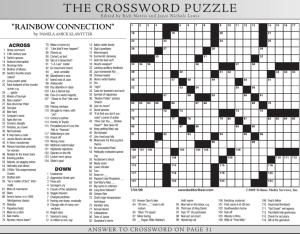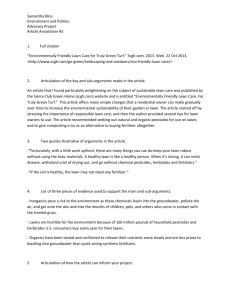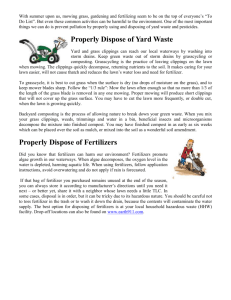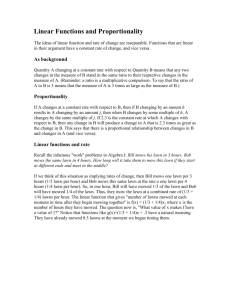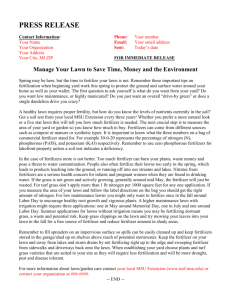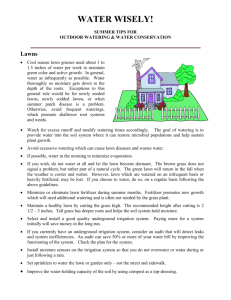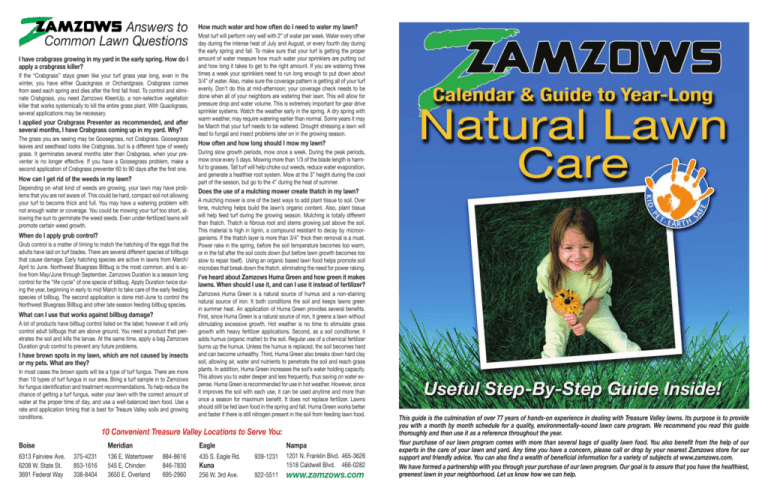
Answers to
Common Lawn Questions
I have crabgrass growing in my yard in the early spring. How do I
apply a crabgrass killer?
If the “Crabgrass” stays green like your turf grass year long, even in the
winter, you have either Quackgrass or Orchardgrass. Crabgrass comes
from seed each spring and dies after the first fall frost. To control and eliminate Crabgrass, you need Zamzows KleenUp, a non-selective vegetation
killer that works systemically to kill the entire grass plant. With Quackgrass,
several applications may be necessary.
I applied your Crabgrass Preventer as recommended, and after
several months, I have Crabgrass coming up in my yard. Why?
The grass you are seeing may be Goosegrass, not Crabgrass. Goosegrass
leaves and seedhead looks like Crabgrass, but is a different type of weedy
grass. It germinates several months later than Crabgrass, when your preventer is no longer effective. If you have a Goosegrass problem, make a
second application of Crabgrass preventer 60 to 90 days after the first one.
How can I get rid of the weeds in my lawn?
Depending on what kind of weeds are growing, your lawn may have problems that you are not aware of. This could be hard, compact soil not allowing
your turf to become thick and full. You may have a watering problem with
not enough water or coverage. You could be mowing your turf too short, allowing the sun to germinate the weed seeds. Even under-fertilized lawns will
promote certain weed growth.
When do I apply grub control?
Grub control is a matter of timing to match the hatching of the eggs that the
adults have laid on turf blades. There are several different species of billbugs
that cause damage. Early hatching species are active in lawns from March/
April to June. Northwest Bluegrass Billbug is the most common, and is active from May/June through September. Zamzows Duration is a season long
control for the “life cycle” of one specie of billbug. Apply Duration twice during the year, beginning in early to mid March to take care of the early feeding
species of billbug. The second application is done mid-June to control the
Northwest Bluegrass Billbug and other late season feeding billbug species.
What can I use that works against billbug damage?
A lot of products have billbug control listed on the label; however it will only
control adult billbugs that are above ground. You need a product that penetrates the soil and kills the larvae. At the same time, apply a bag Zamzows
Duration grub control to prevent any future problems.
I have brown spots in my lawn, which are not caused by insects
or my pets. What are they?
In most cases the brown spots will be a type of turf fungus. There are more
than 10 types of turf fungus in our area. Bring a turf sample in to Zamzows
for fungus identification and treatment recommendations. To help reduce the
chance of getting a turf fungus, water your lawn with the correct amount of
water at the proper time of day, and use a well-balanced lawn food. Use a
rate and application timing that is best for Treaure Valley soils and growing
conditions.
How much water and how often do I need to water my lawn?
Most turf will perform very well with 2” of water per week. Water every other
day during the intense heat of July and August, or every fourth day during
the early spring and fall. To make sure that your turf is getting the proper
amount of water measure how much water your sprinklers are putting out
and how long it takes to get to the right amount. If you are watering three
times a week your sprinklers need to run long enough to put down about
3/4” of water. Also, make sure the coverage pattern is getting all of your turf
evenly. Don’t do this at mid-afternoon; your coverage check needs to be
done when all of your neighbors are watering their lawn. This will allow for
pressure drop and water volume. This is extremely important for gear drive
sprinkler systems. Watch the weather early in the spring. A dry spring with
warm weather, may require watering earlier than normal. Some years it may
be March that your turf needs to be watered. Drought stressing a lawn will
lead to fungal and insect problems later on in the growing season.
How often and how long should I mow my lawn?
During slow growth periods, mow once a week. During the peak periods,
mow once every 5 days. Mowing more than 1/3 of the blade length is harmful to grasses. Tall turf will help choke out weeds, reduce water evaporation,
and generate a healthier root system. Mow at the 3” height during the cool
part of the season, but go to the 4” during the heat of summer.
Does the use of a mulching mower create thatch in my lawn?
A mulching mower is one of the best ways to add plant tissue to soil. Over
time, mulching helps build the lawn’s organic content. Also, plant tissue
will help feed turf during the growing season. Mulching is totally different
than thatch. Thatch is fibrous root and stems growing just above the soil.
This material is high in lignin, a compound resistant to decay by microorganisms. If the thatch layer is more than 3/4” thick then removal is a must.
Power rake in the spring, before the soil temperature becomes too warm,
or in the fall after the soil cools down (but before lawn growth becomes too
slow to repair itself). Using an organic based lawn food helps promote soil
microbes that break down the thatch, eliminating the need for power raking.
I’ve heard about Zamzows Huma Green and how green it makes
lawns. When should I use it, and can I use it instead of fertilizer?
Zamzows Huma Green is a natural source of humus and a non-staining
natural source of iron. It both conditions the soil and keeps lawns green
in summer heat. An application of Huma Green provides several benefits.
First, since Huma Green is a natural source of iron, it greens a lawn without
stimulating excessive growth. Hot weather is no time to stimulate grass
growth with heavy fertilizer applications. Second, as a soil conditioner, it
adds humus (organic matter) to the soil. Regular use of a chemical fertilizer
burns up the humus. Unless the humus is replaced, the soil becomes hard
and can become unhealthy. Third, Huma Green also breaks down hard clay
soil, allowing air, water and nutrients to penetrate the soil and reach grass
plants. In addition, Huma Green increases the soil’s water holding capacity.
This allows you to water deeper and less frequently, thus saving on water expense. Huma Green is recommended for use in hot weather. However, since
it improves the soil with each use, it can be used anytime and more than
once a season for maximum benefit. It does not replace fertilizer. Lawns
should still be fed lawn food in the spring and fall. Huma Green works better
and faster if there is still nitrogen present in the soil from feeding lawn food.
10 Convenient Treasure Valley Locations to Serve You:
Boise
6313 Fairview Ave.
6208 W. State St.
3691 Federal Way
Meridian
375-4231
853-1616
338-8404
136 E. Watertower
545 E. Chinden
3650 E. Overland
Eagle
884-8616
846-7830
695-2960
435 S. Eagle Rd.
Nampa
939-1231
1201 N. Franklin Blvd. 465-3626
1518 Caldwell Blvd. 466-0282
922-5511
www.zamzows.com
Kuna
256 W. 3rd Ave.
This guide is the culmination of over 77 years of hands-on experience in dealing with Treasure Valley lawns. Its purpose is to provide
you with a month by month schedule for a quality, environmentally-sound lawn care program. We recommend you read this guide
thoroughly and then use it as a reference throughout the year.
Your purchase of our lawn program comes with more than several bags of quality lawn food. You also benefit from the help of our
experts in the care of your lawn and yard. Any time you have a concern, please call or drop by your nearest Zamzows store for our
support and friendly advice. You can also find a wealth of beneficial information for a variety of subjects at www.zamzows.com.
We have formed a partnership with you through your purchase of our lawn program. Our goal is to assure that you have the healthiest,
greenest lawn in your neighborhood. Let us know how we can help.
MARCH
APRIL
JUNE~JULY~AUGUST
SEPTEMBER~OCTOBER
This is the time to prevent crabgrass and spurge that are such a
problem in our area. It is very important to begin a consistent
fertilization program for your lawn, trees, shrubs and perennial beds.
Last but not least, take steps to prevent future insect damage to
your lawn, trees and shrubs.
• To prevent crabgrass, spurge and other grassy weeds apply a
pre-emergent herbicide to your lawn when the soil temperature reaches approximately 50 degrees (a good indicator is the
blooming of the forsythia bush). Apply Zamzows Defendz
Crabgrass Preventer to prevent seed germination for up to
90 days.
A note of caution when planting or repairing lawns: Since crabgrass
preventers stop all grass seed germination, don’t apply crabgrass
preventer to areas you will be seeding in the next three months.
• It’s time for your first application of Zamzows Lawn Food.
Our slow-release organic-based lawn food will bring back that
deep green to your lawn. Apply at a rate of one bag per 2,500
sq. ft. You will need a second application of Zamzows Lawn
Food in about six weeks.
• Fertilize your dormant perennials and trees with Zamzows
Thrive or Thrive Extra. Thrive products provide your perennials
with the nutrients and minerals the plants will need to thrive in
the season ahead.
• Apply Zamzows Tree & Shrub Insect Control to trees and
shrubs. One application kills insects and prevents new
infestations for an entire year.
Note: More than any other thing you do for your trees and
shrubs, timely application of both Zamzows Thrive and Zamzows
Tree & Shrub Insect Control will save you effort and expense
throughout the year.
• Apply Zamzows Duration Grub Control in early to mid March
to prevent spring season lawn insect damage. Note: The most
damaging lawn pest is the billbug in its larvae stage. The Treasure Valley has several billbug species that hatch at different
times and must be controlled by two separate properly-timed
applications. Re-apply Zamzows Duration in June to control
summer billbug infestations.
• Start controlling broadleaf weeds that may have overwintered in
your lawn, and new weeds such as dandelions, clover, thistle,
etc. that show up as the temperature warms. Spot spray
Zamzows Ultra Weed Control. Most weed killers are only effective above 65 degrees. Zamzows Ultra Weed Control starts working at 45 degrees, allowing you a head start on weed control.
• Whenever Ultra Weed Control or other liquid lawn/garden products are used, mix Zamzows Stay Put with the liquid product and
water in a tank sprayer. Stay Put is a wetting, penetrating, and
adhering agent that improves product performance by helping the
sprayed mixture “stick” to the plant.
• To begin protection of roses and flowers, apply Zamzows
Defendz Systemic Rose Drench at six-week intervals throughout the growing season. This product protects plants, even new
growth, against insects and diseases.
Note: Following the recommended applications and prevention
measures will save a lot of work and money this summer.
April is a great time to over-seed sparse or previously damaged
lawns. Over-seeding fills in the sparse areas and thickens the
lawn. April is also the best month to lay sod or plant a new lawn
from seed. Starting a new lawn from scratch is no small task and
could require a booklet of its own. Visit your nearest Zamzows
store and let us personally assist you with your new lawn.
• Apply your second application of Zamzows Lawn Food,
approximately six weeks after your first lawn feeding. Apply
at a rate of one bag per 5,000 sq. ft.
• Give your roses a feeding of Zamzows Thrive or Thrive
Extra. Repeat feedings monthly during the growing season.
• Apply soil conditioners to your lawn to break up the heavy
clay soil common to the Treasure Valley. We recommend
Zamzows PenaTurf, an easy to apply all-natural liquid soil
conditioner or Zamzows Pelleted Gypsum. Also, apply soil
sulfur to correct high soil ph and make minerals available to
the grass plants. Zamzows Huma Green can be applied in
place of soil sulfur for the same purpose and more. Huma
Green will be covered in more depth later in this document.
• Start watering your lawn an average of 1/2” twice a week.
Pay special attention to the corners of the lawn and other
areas that may not be getting adequate water (additional
adjustments in the hot summer months may also be required).
• Use a rain gauge to determine the amount of water that
reaches the lawn from each sprinkler. Note that if you have
a sprinkler system, the time for each station may need to be
adjusted.
• With a rain gauge time how long it takes to get 1/2” of water.
This is how long the station needs to run. Not all stations will
deliver 1/2” in the same number of minutes. Check each one.
• If you have not yet applied Zamzows Duration for grub control, apply it now to prevent insect damage in later months.
The most important thing in maintaining your lawn is following
proper summer watering procedures. The stress of high heat, insects, and disease make lawn maintenance a challenge. Follow the
suggestions listed below to ease the challenge of keeping your lawn
green during high summer heat.
• Apply the second application of Zamzows Duration insect
control in June.
• Tug on the blades of grass in dead areas. Billbug damaged
grass pulls up easily and is yellow. Drought damaged grass
does not pull up and appears more blue or gray. The Bluegrass
Billbug lays its eggs in April and May, and their larvae usually
begin to do serious damage during the heat of the summer. If
you discover billbug damage, apply a contact kill grub control
to immediately stop larvae that are feeding and be sure to apply
Zamzows Duration, as previously mentioned, to prevent further
damage for the rest of the season.
Basic things you can do to help your lawn deal with summer
heat stress:
• Set your mower height at least one inch higher than you do in
spring and fall. The taller plant will help shade the root zone.
• Do not fertilize during these hot months. The residual nutrients
from your spring feedings will suffice during the slowed
summer-growth period.
• Keep your mower blade sharp and mow often. Leave the small
clippings on the lawn to decompose. This will replace needed
organic matter in your soil.
• It’s time for your application of Zamzows Huma Green.
In June and early July, lawns tend to lose color quality. Hot
weather is not the time to stimulate grass with heavy fertilizer
applications. This organic iron supplement will green your lawn
without growth. It is also a great soil conditioner that adds
humus to the soil, breaks down hard clay soil and improves
the soil’s water holding capacity. Since Huma Green improves
the soil every time it is used, apply it more than once during
the year, in addition to this program application. Huma Green
should always be applied at a rate of one bag per 2,500 sq. ft.
• It’s best to water your lawn in the early morning hours for two
reasons:
Save water. On a 100-degree day almost 30% of the water from
your sprinkler can evaporate before it even hits the ground!
Increase to 1” inch per watering, two times per week.
Night watering can cause fungal problems. Brown patches,
circles, semi-circles or mushrooms in your lawn can indicate
fungus. Zamzows Defendz Systemic Disease Control will
cure and prevent most lawn fungal problems. Let the lawn care
specialist at your nearest Zamzows help solve these problems.
• Apply Zamzows Defendz Systemic Rose Drench according to
your six-week interval schedule established in March.
Continue your summer watering schedule through September.
This month also begins the rebuilding season for Southern
Idaho lawns. The cooler nights let the grass breathe a sigh of
relief from the heat. This is the most important time of the year
for fertilization. We recommend two end-of-season lawn feedings: The first in September and the second six weeks later in
either October or November. Fall is the ideal time to also feed
the trees in your yard. Long before the leaves change color they
stop taking up nutrients and take in less water.
• September is the time for your next application
Zamzows Lawn Food. Your lawn has not been fed since
early summer and needs food to begin the recovery
process from summer heat. Apply at a rate of one bag per
5,000 sq. ft.
• Apply Zamzows Thrive or Thrive Extra to trees in early
September.
• Reduce mowing height down to fall levels and continue
mowing frequently to recycle organic material back into the
soil.
• October or November is the time to apply Zamzows Fall
Lawn Food, approximately six weeks after the September
application. This fall application encourages root growth,
promotes grass to fill in open areas and slow feeds over the
winter. Apply at a rate of one bag per 2,500 sq. ft.
MAY
Lawn pest damage can really start to show up in May. Billbugs
and similar pests attack lawns when temperatures rise into the
80’s. Also, watch for small moth activity in or around your lawn.
The larvae these moths produce become active very suddenly
and cause damage to your lawn.
• Apply Zamzows Lawn Food at a rate of one bag per 5000
sq. ft., if it’s been six weeks or more since your first lawn
feeding.
• Apply the second application of Zamzows Thrive or Thrive
Extra to your roses. Their unique balanced trace-mineral formulas strengthen your roses, keeping them healthy, naturally.
• To continue protection for your roses and flowers, apply
Zamzows Defendz Systemic Rose Drench according to
your six-week interval schedule established in March.
NOVEMBER ~ DECEMBER
Relax! You’ve earned it! The money you saved on lawn care
can now buy you the best Christmas tree in town. Zamzows
sells only fresh-cut, Oregon-grown Christmas trees. They
usually arrive by the weekend after Thanksgiving. Enjoy the
holidays! When the New Year arrives, within a few short weeks,
it’ll be time to start preparing for spring!
• One final mowing in early November will help clean up all of
the leaves in your yard.
• Keep the turf short in winter to help prevent some types of
lawn fungus.
As the weather gets colder, your animals have increased nutritional and other special needs. The experts at Zamzows can
help keep your animals healthy and happy this winter.
Don’t forget your pet at Christmas!
Zamzows carries a huge selection of gifts and stocking stuffers
perfect for your special pet.
Copyright Zamzows, Inc. 2010 – All Rights Reserved


